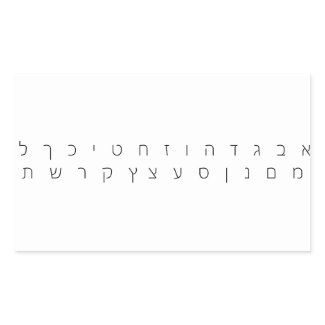בס"ד
Hebrew for ME! עברית בשבילי
Lesson 1 שיעור
Hebrew is the language of Israel, but also of History. Many people have different reasons for wanting to learn Hebrew and yes, there are many Hebrew books that have been published to teach Hebrew. I have been teaching Hebrew for many years and sometimes I feel that Beginning Hebrew students need more of a conversational approach.

Hebrew Alphabet Sticker
by Rachael_Alice
This is the Hebrew Alphabet, I made it into a sticker that you can put on your book cover, or on your bathroom mirror, or anywhere else so that you can remind yourself of the Hebrew Letters every day. You can get this on zazzle.com
Hebrew has letters and vowels. The letters are all the same case, all the time, although there are different Hebrew fonts, the letters themselves don't have a Big letter or a small letter like English.
The vowels in Hebrew go either on the side of the letter or underneath. We will be learning Hebrew with the vowels at first and then slowly, slowly, the vowels will disappear and you will be able to read Hebrew without vowels.
Now the Alphabet.
א Aleph This is usually understood as the a like in English, but the א doesn't really have it's own sound. It takes the sound of which ever vowel is under it or to the side. it is considered a throat sound.
בּ Bet This is pronounced b when it has the dot which is called a dagesh. The Bet is b when the letter is at the beginning of the word or syllable. A Hebrew word can never end with a b sound.
ב Vet This is pronunced v when it doesn't have a dagesh. This is usually in the middle of a word or at the end of a word.
ג Gimel This a g sound, it is considered one of the letters which has a dagesh, although in Modern Hebrew pronunciation we don't use the dagesh and make a difference.
ד Dalet This is a d sound, it is considered one of the letters which has a dagesh, although in Modern Hebrew pronunciation we don't use the dagesh and make a difference.
ה Hay This is a h sound and it is considered a throat sound. It sometimes is pronounced with a puff of air.
ו Vav This is the v sound, and the letter is also used as a to help with writing vowels, וְ ve וֹ oh וּ oo
ז Zayin This is the sound z
ח Chet This is che, the sound is in the throat like you are clearing your throat. It is the classical throat sound.
ט Tet This is a light t sound. If a word comes from another language, then you might use the ט instead of the ת to spell the word.
י Yud This is a y sound, and it can also be used to help with vowel sounds. יִ yee
כּ Kaf This is the k sound, it is not a throat letter. It has three forms, one with the dagesh, one without and one at the end of a word.
כ Chaf This is a ch sound, but it comes from the palate, not the throat so this is not a throat letter.
ך Chaf sofit This is the final chaf, ch sound, sometimes it takes a vowel and sometimes not. ךָ Here the chaf will be cha because it has the Kametz vowel.
ל Lamed This is the l sound
מ Mem This is the m sound, it has two forms this one is in the beginning or middle of the word.
ם Mem sofit This is the m but only at the end of a word, and it never takes a vowel.
נ Nun This is the n sound, it has two forms this one is in the beginning or middle of the word.
ן Nun sofit This is the n sound at the end of the word, it sometimes very rarely can take the kametz vowel.
ס Samech This is the s sound. If a word If a word comes from another language, then you might use the ס instead of the ש (sin) to spell the word.
ע Ayin This is the a sound, but with a bit of the throat involvement. You say it with a gh sound. It is a throat letter.
צ Tsadi This is a ts together, maybe like a Chinese ts. It has a final form that is used at the end of a word.
ץ Tsadi sofit Used at the end of a word, never takes a vowel.
ק Kuf This is the k sound, not considered a throat letter.
ר Resh This is the r sound, sometimes words will change because of this letter.
שׁ Shin. This is the sh sound. The two letters שׁ and שׂ look alike, except for the placement of the dot, but they are different letters and the meaning is different.
שׂ Sin This is the s sound. There aren't as many words that use the שׂ as the שׁ
ת Tof This is the t sound. it is considered one of the letters which has a dagesh, although in Modern Hebrew pronunciation we don't use the dagesh and make a difference in the sound.
If you want private lessons with Rachael Alice go here: https://www.italki.com/teacher/1581946
Disclaimer If you buy from the links on this page I will get a small percentage of the sale with no addtional charge to you. This helps me to keep the blog in business. Thank you.
Here is another Hebrew Alphabet Chart: https://theisraelbible.com/hebrew-alphabet-chart/download
Here is the course up to date: Watch them in order!




No comments:
Post a Comment